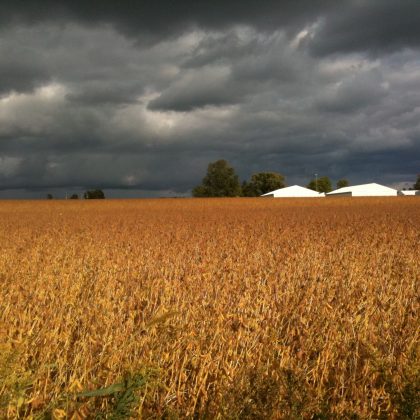Confronting Drought Impacts in Puerto Rico
There was a time when agriculture was widespread across all of Puerto Rico, and many of its citizens were in some way associated with agricultural labor. While recently building my family tree, I was surprised to discover that all of my Puerto Rican grandparents and great-grandparents were farmers or were associated with farming in many ways! However, the increasing industrialization in the mid-1900s caused a shift in the economy that pushed much of the population, including some of my ancestors, to take root in the cities where there were more job opportunities. Only recently have Puerto Ricans begun returning to the countryside to join hands with remaining farmers – who persisted through this agricultural slump – in revitalizing the island’s agricultural sector. This new generation of farmers aims to increase local food production and foster a land-based economy.
This resurgence has not come easily given recent climatic challenges. In the last four years, farmers have had to cope with three years of moderate-to-extreme drought followed by two major hurricanes. The drought caused millions in losses due to reductions in crop yields and temporary land idling. Estimates indicate that over US$2.3 billion were lost in crop production due to the combined impacts of hurricanes Irma and Maria (Puerto Rico Department of Agriculture, 2017). As a fellow in the USDA Caribbean Climate Hub, I’m interested in analyzing effects of extreme events to our island’s agriculture at the landscape scale, and to evaluate available alternatives to better deal with these impacts.

In this climate change-themed issue of Renewable Agriculture and Food Systems, our research objective was to evaluate drought exposure in Puerto Rico to analyze agricultural lands that were subject to drought conditions during 2000 and 2016. This analysis emphasized the recent extreme drought event that affected Puerto Rico and the Virgin Islands from 2014-2016. To do this, we combined 17 years of weekly drought maps from the United States Drought Monitor into a single map to identify areas of high drought exposure on the island. The map highlighted the eastern and southern parts of the island as the regions most exposed to drought, with a maximum of 128 non-consecutive weeks of drought during this period. In the 2014-2016 drought event, the eastern half of the island endured the most prolonged period of drought with up to 80 weeks in moderate drought conditions. In 2015 in particular, drought heavily impacted the livestock sector (62.2% of all reported economic losses), followed by the plantain sector (22%). The remaining 10% of the losses were attributed to a wide variety of 21 crops, including bananas, root and tuber crops, herbs, fruits and coffee. This highlights how agricultural drought in Puerto Rico is a major concern, and especially so on account that 90% of farmlands in the territory are rainfed.
In this work we also documented that the Natural Resources Conservation Service (NRCS) Environmental Quality Incentives Program (EQIP) has 44 conservation practices that could directly or indirectly contribute to drought mitigation through promoting soil moisture, plant health, and methods to store or conserve available water. A few examples of recommended drought-related practices include the incorporation of cover crops, and the development of ponds, wells, and springs, among other practices. Approximately 7,000 farm units all over Puerto Rico had at least one or a combination of these practices during the study period, but areas highly exposed to drought did not show a statistically significant agglomeration of such practices. This gap indicated that areas highly exposed to drought lacked conservation practices, or at least those practices sponsored by NRCS. These areas affected by past droughts are projected to undergo future drought conditions as modeled in downscaled climate projections. We recommend that conservation practices should be targeted towards areas where they would be needed most. We also discuss possible reasons why the adoption of practices to mitigate drought do not correspond to areas exposed to drought.

In Puerto Rico, droughts tend to be sidelined in the face of more striking events such as hurricanes. Drought continues to be a severe phenomenon on the islands and deserves increasing attention. For instance, the extent to which specific conservation practices can reduce drought vulnerability in tropical agriculture is an important area for future research. Additionally, increased research attention should also be given to understand farmers’ motivations or obstacles for enrollment in conservation programs, particularly those that are related to drought adaptation.
Download the full article: Correlating drought conservation practices and drought vulnerability in a tropical agricultural system. Álvarez-Berríos, N., Soto-Bayó, S., Holupchinski, E., Fain, S., & Gould, W. (2018). Published in the June 2018 Special Issue in Renewable Agriculture and Food Systems,33(3), 279-291. doi:10.1017/S174217051800011X for free until 31st July 2018
References:
Daly C, Helmer EH and Quinones M (2003) Mapping the climate of Puerto Rico, Vieques and Culebra. International Journal of Climatology 23, 1359–1381.
Henareh A, Gould WA, Harmsen E, Terando A, Quinones M and Collazo JA (2016) Climate change implications for tropical islands: Interpolating and interpreting statistically downscaled GCM projections for management and planning. Journal of Applied Meteorology and Climatology 55, 265–282
Puerto Rico Department of Agriculture (2018) Agricultural losses by product – Preliminary estimates based on SEPA (Emergency System for Agriculture). Agricultural Statistics Division. Retrieved from: http://caribbeanclimatehub.org/factsheets
List of media resources
Blog:
http://caribbeanclimatehub.org/drought-study/
Videos:
Permaculture, Soil and Water Conservation facing Climate Change
English version: https://youtu.be/zs148VNxCpw
Spanish version: https://youtu.be/uN3j_kAzuro
Climate Resilient Agriculture: Plantains and Vegetables
English version: https://youtu.be/qr_N0e1jPPs
Spanish version: https://youtu.be/tlDVor3Qt2E
Vídeo for kids
English version: https://youtu.be/n8aCW8Ps4D8
Spanish version: htpps://youtu.be/JpTaaC4Wpug
Coloring book for kids
English version: http://caribbeanclimatehub.org/wp-content/uploads/2017/04/Libro-de-Pintar-Huerto-FINAL-INGLES.pdf
Spanish version: http://caribbeanclimatehub.org/wp-content/uploads/2017/04/Libro-de-Pintar-Huerto-FINAL-ESPANOL.pdf
Factsheet:
Drought Effects on Forests and Rangelands in the US-Caribbean
English version:
Spanish version:
Infographic:
Agricultural Conservation Practices for Climate Risk Reduction
Photo credits:
Photo 1 by: Manuel Matos, NRCS
Photo 2 by: Samuel Rios, NRCS
GIFF: Average annual rainfall and projected rainfall. Created by Eva Holupchinski







Muy entretenido el Blog! Gracias por compartir 🙂